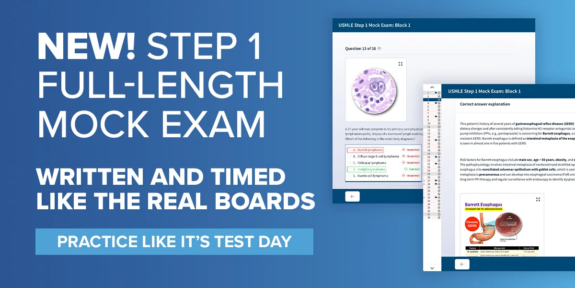The Clinical Basic Science Self-Assessments (CBSSA), released by the NBME, should be integral to any USMLE Step 1 study plan. These tests are traditionally referred to as NBME practice tests. They consist of retired exam questions reformatted into practice assessments and in the past, your NBME score report provided you with a good prediction of how you’d do on test day.
With Step 1 now being a pass/fail exam, these practice exams are being scored a bit differently and many wonder what their results now mean in terms of their exam preparedness. Read on to learn more about these changes and the way they may influence the interpretation of your NBME score report.
Looking for more Step 1 practice? Get ready to pass with Blueprint’s full-length Step 1 Mock Exams! Assess your skills and perfect your exam strategy with the most realistic mock exams. Get started today with 2 mock exams for the price of 1!
What has changed in the NBME score report?
Because the Step 1 examination is now pass/fail, the score reports for the associated practice tests have converted to a similar format and no longer use three-digit scores. Instead, you’ll receive the two following numbers on your NBME score report:
Equated Percent Correct Score
The equated percent correct score is an approximation of the percentage of questions you answered correctly on the exam. Some adjustment is made for any individual exam depending on its difficulty in order to standardize this number. This adjustment allows for comparison between different tests. In other words, if you have a harder test, your true percentage will be curved up to a higher equated percent correct score.
Probability of Passing Step 1
The probability of passing Step 1 is easier to interpret: it’s simply an estimation of your likelihood to pass the exam if you’re going to take it in the next week. This number is difficult to convert back to a three-digit score like the old graded version of the exam, but a 50 percent likelihood of passing should be roughly equivalent to the previous passing score of 194.
Check out a sample NBME score report below!
Source: NBME
What will my exam day score report include?
Because the exam is pass/fail, your Step 1 score report after taking the actual exam will specify only whether you passed. It will not include your equated percent correct score. In other words, passing scores will not be stratified, and you will not receive any numerical representations of your performance. If you fail the exam, however, the report will provide more information to help you understand the result and to identify areas for improvement for when you take the exam again. You’ll receive graphical representations of how you performed relative to your peers overall and within different disciplines to determine your strengths and weaknesses.
To view a Step 1 score report for a passing score vs a failing score, check out these sample reports from NBME!
What does this change in the NBME score report mean for me?
As before, you should schedule the exam once you’ve taken enough practice tests and scored comfortably within passing range. A general rule of thumb is to try to have at least 3 practice tests with a 95 percent or greater likelihood of passing—however, the ideal threshold may change with time as we get more accustomed to this format. Regardless, if you’re consistently achieving a greater than 98 or 99 percent likelihood of passing on multiple practice tests, this is a strong indicator you’re ready to proceed with Step 1.Remember that even though Step 1 is pass/fail, the preparation itself remains the same as those who took the graded exam. You should still rely on Step 1 question banks, textbooks, and video resources used in the past, as well as additional Step 1 mock exams!
Best of luck as you head into your Step 1 dedicated study time—you got this!





